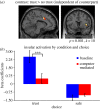Neural signatures of betrayal aversion: an fMRI study of trust
- PMID: 24648217
- PMCID: PMC3973250
- DOI: 10.1098/rspb.2013.2127
Neural signatures of betrayal aversion: an fMRI study of trust
Abstract
Decisions are said to be 'risky' when they are made in environments with uncertainty caused by nature. By contrast, a decision is said to be 'trusting' when its outcome depends on the uncertain decisions of another person. A rapidly expanding literature reveals economically important differences between risky and trusting decisions, and further suggests these differences are due to 'betrayal aversion'. While its neural foundations have not been previously illuminated, the prevailing hypothesis is that betrayal aversion stems from a desire to avoid negative emotions that arise from learning one's trust was betrayed. Here, we provide evidence from an fMRI study that supports this hypothesis. In particular, our data indicate that the anterior insula modulates trusting decisions that involve the possibility of betrayal.
Keywords: betrayal aversion; fMRI; trust.
Figures




References
-
- Fehr E. 2009. On the economics and biology of trust. J. Eur. Econ. Assoc. 7, 235–266 (doi:10.1162/JEEA.2009.7.2-3.235) - DOI
-
- Bohnet I, Zeckhauser R. 2004. Trust, risk and betrayal. J. Econ. Behav. Organ. 55, 467–484 (doi:10.1016/j.jebo.2003.11.004) - DOI
-
- Bohnet I, Grieg F, Herrmann B, Zeckhauser R. 2008. Betrayal aversion: evidence from Brazil, China, Oman, Switzerland, Turkey, and the United States. Am. Econ. Rev. 98, 294–310 (doi:10.1257/aer.98.1.294) - DOI
-
- Houser D, Schunk D, Winter J. 2010. Distinguishing trust from risk: an anatomy of the investment game. J. Econ. Behav. Organ. 74, 72–81 (doi:10.1016/j.jebo.2010.01.002) - DOI
-
- Aimone JA, Houser D. 2011. Beneficial betrayal aversion. PLoS ONE 6, e17725 (doi:10.1371/journal.pone.0017725) - DOI - PMC - PubMed
Publication types
MeSH terms
LinkOut - more resources
Full Text Sources
Other Literature Sources
Medical
